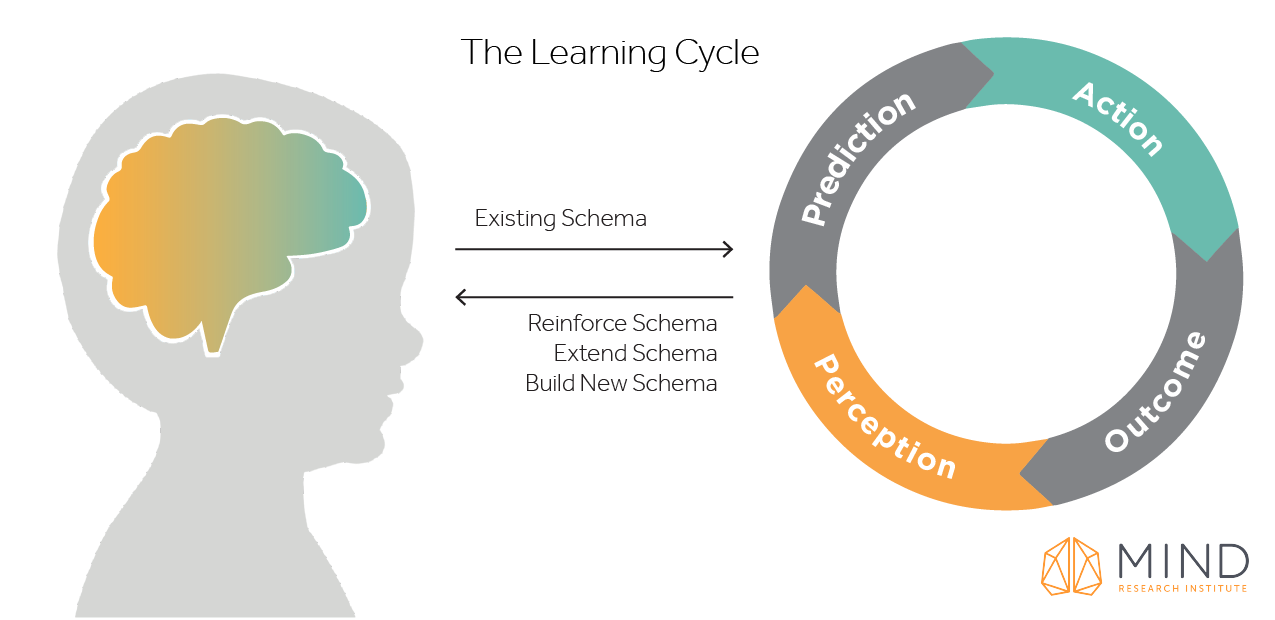
A toddler scoops up mud, loving the way it squishes between his fingers. As he brings the wet, cool clump to his lips his caretaker warns, “No! That’s gross!” He puts it in his mouth anyway and a moment later his face wrinkles, he starts crying and spitting out the dirt.
Humans learn through this same basic process throughout life -- not by being told, but by doing. We’re hardwired to learn by interacting with the world around us and then perceiving the results. Neuroscientists call this simple yet powerful system the perception-action cycle.
Neuroscientists describe human learning through the perception-action cycle.
Our brain makes sense of the world around us by creating and testing hypotheses about the way the world works.
When presented with new situations, our brain makes predictions based on past experiences, takes action based on those hypotheses, perceives the results and adjusts its hypotheses.
All goal directed behavior is performed within the broad context of the perception-action cycle, which is grounded on a basic biological principle: the circular cybernetic flow of cognitive information that links the organism to its environment.
— Joaquín M. Fuster, Physiology of Executive Functions: The Perception-Action Cycle
In general, the posterior brain areas handle sensory perception such as seeing and hearing, while the more frontal brain regions are in charge of motor skills, planning and decision-making. The front and back of the brain work together, with information flowing between them.
Before we make a decision or take action, the prefrontal cortex is involved in considering both the information it is receiving from the back of the brain (perceptions), as well as stored memories or experiences that relate to it. The prefrontal cortex helps make a prediction of what will happen and initiates the appropriate body movement.
As the brain perceives the result of the action made by the body, it either reinforces the brain’s existing neural networks of understanding about how the world works, or begins to create new ones.
The perception-action cycle is this continuous flow of information and action between the brain and the world around it. On and on it goes: sense, predict, act, adjust. Sense, predict, act, adjust.

The perception-action cycle is a feedback loop helping us build an understanding of how the world works.
For example, if you see a cup, you know what it is and what to do with it, even if you’ve never seen that exact cup before. And you don’t even have to think about it, because your brain has already built circuitry dedicated to its understanding of cups.
In fact, you have a rich network of understanding, what Piaget called schemas, about cups. Your brain also has associated movements connected to those schemas — you automatically reach for a coffee mug differently than a wine glass. And you don’t have to think about that, either.
Knowledge like this that gets encoded in our brain through the perception-action cycle is extremely powerful and easy to retrieve. And that’s what makes the perception-action cycle so valuable: it is the natural, automatic way we make sense of the world around us, and decide how to live in that world.
Movement is key to triggering the perception-action cycle: a person must take physical action to change the world around them, and then observe the result of that action.
One of the reasons scientists believe motor processes help learners retain information is that movements provide additional cues with which to retrieve knowledge.
Seeing, hearing, and acting on information all activate different neural pathways in the brain. As a result, the learner has multiple avenues their brain can then use to retrieve the information later — even in situations like tests that don’t involve movement.
Consider this example. Researchers showed both trained dancers and non-dancers the same dance video, measuring the brain activity of both groups. They found greater activity in the brain regions responsible for movement among the dancers than the non-dancers who watched the same video.
Why? The dancers had made great use of the perception-action cycle through their dance training, encoding the information required to perform dance moves. When they viewed the dance video, their brain accessed that information even though they weren’t moving.
When we understand how important the perception-action cycle is to learning, it’s clear that we need to put it to use in school.
Manipulatives that allow students to get hands-on with the content they are learning are one straight forward way to kick the the perception-action cycle into gear. For example, exploring subtraction with counting cubes can help students develop a conceptual understanding of basic arithmetic.
But the perception-action cycle is also critical to learning with visual and symbolic representations of actions. Research shows that using mental pictures to imagine how a 3D object looks when rotated, or using motions to simulate new vocabulary words, engages the perception-action cycle and improves student learning.
In fact, scientists have found that even small movements like pointing to numbers in an equation — or interactive touchscreens like iPads — provide opportunities to invoke the perception-action cycle that results in deeper learning.
Much like a toddler and a puddle of mud, we learn best when we — literally— get our hands dirty and interact with the world.
Comment